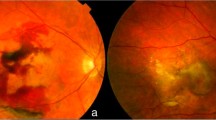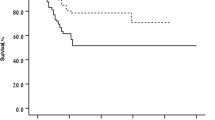Abstract
Purpose
Inconsistent data exist on long-term visual outcomes in survivors of retinoblastoma. No studies have been reported on role of ocular coherence tomography (OCT) in predicting visual acuity. We assessed visual acuity in patients with retinoblastoma treated at our center in whom affected eyes were preserved.
Methods
Patients who had completed a 2-year follow-up and were more than 5 years of age at assessment were included. Clinical data were obtained from database and factors predicting visual acuity were analyzed. OCT was performed in these patients to assess central macular thickness (CMT).
Results
Visual outcomes were assessed in 45 eyes of 43 patients, of which 38 (88 %) had bilateral retinoblastoma. The median age at diagnosis was 12 months. Sixty percent (27/45) had International classification of retinoblastoma group C or D disease with 40 % eyes showing macular lesions. The far visual acuity was better than 6/12 in 53 % (24/45), 6/12 to 6/60 in 40 % (18/45) and 6/60 in 7 % (6/60). Macular location and International classification of retinoblastoma predicted poor vision (p = 0.06 and 0.07, respectively). CMT was less than 200 μm in 3 of 36 eyes (8 %) and 1 eye showed epiretinal membrane. Radiotherapy was associated with foveal thinning (p = 0.003). Two of 3 eyes with foveal thinning had a vision of 6/60.
Conclusions
Good visual outcomes were observed in half of retinoblastoma patients treated with eye preservation. Macular location and International classification of retinoblastoma group C and D predicted poor visual acuity, while previous radiotherapy predicted foveal thinning, which was associated with poor visual acuity.

Similar content being viewed by others
References
Houston SK, Murray TG, Wolfe SQ, Fernandes CE. Current update on retinoblastoma. Int Ophthalmol Clin. 2011;51:77–91.
Shields CL, Mashayekhi A, Au AK, Czyz C, Leahey A, Meadows AT, et al. The international classification of retinoblastoma predicts chemoreduction success. Ophthalmology. 2006;113:2276–80.
Shields CL, Shields JA. Basic understanding of current classification and management of retinoblastoma. Curr Opin Ophthalmol. 2006;17:228–34.
Schefler AC, Abramson DH. Retinoblastoma: what is new in 2007–2008. Curr Opin Ophthalmol. 2008;19:526–34.
Berry JL, Jubran R, Wong K, Lee TC, Murphree AL, Kim JW. Factors predictive of long-term visual outcomes of Group D eyes treated with chemoreduction and low-dose IMRT salvage: the Children’s Hospital Los Angeles experience. Br J Ophthalmol. 2014;98:1061–5.
Migdal C. Bilateral retinoblastoma: the prognosis for vision. Br J Ophthalmol. 1983;67:592–5.
Desjardins L, Chefchaouni MC, Lumbroso L, Levy C, Asselain B, Bours D, et al. Functional results after treatment of retinoblastoma. J Publ Am Assoc Pediatr Ophthalmol Strabismus. 2002;6:108–11.
Demirci H, Shields CL, Meadows AT, Shields JA. Long-term visual outcome following chemoreduction for retinoblastoma. Arch Ophthalmol Chic Ill. 1960;2005(123):1525–30.
Schefler AC, Cicciarelli N, Feuer W, Toledano S, Murray TG. Macular retinoblastoma: evaluation of tumor control, local complications, and visual outcomes for eyes treated with chemotherapy and repetitive foveal laser ablation. Ophthalmology. 2007;114:162–9.
Narang S, Mashayekhi A, Rudich D, Shields CL. Predictors of long-term visual outcome after chemoreduction for management of intraocular retinoblastoma. Clin Exp Ophthalmol. 2012;40:736–42.
Hall LS, Ceisler E, Abramson DH. Visual outcomes in children with bilateral retinoblastoma. J Publ Am Assoc Pediatr Ophthalmol Strabismus. 1999;3:138–42.
Weiss AH, Karr DJ, Kalina RE, Lindsley KL, Pendergrass TW. Visual outcomes of macular retinoblastoma after external beam radiation therapy. Ophthalmology. 1994;101:1244–9.
Lam BL, Judisch GF, Sobol WM, Blodi CF. Visual prognosis in macular retinoblastomas. Am J Ophthalmol. 1990;110:229–32.
Shields CL, Mashayekhi A, Luo CK, Materin MA, Shields JA. Optical coherence tomography in children: analysis of 44 eyes with intraocular tumors and simulating conditions. J Pediatr Ophthalmol Strabismus. 2004;41:338–44.
Levin LA, Gragoudas ES, Lessell S. Endothelial cell loss in irradiated optic nerves. Ophthalmology. 2000;107:370–4.
Danesh-Meyer HV. Radiation-induced optic neuropathy. J Clin Neurosci. 2008;15:95–100.
Shields CL, Manalac J, Das C, Saktanasate J, Shields JA. Review of spectral domain-enhanced depth imaging optical coherence tomography of tumors of the retina and retinal pigment epithelium in children and adults. Indian J Ophthalmol. 2015;63:128–32.
Author information
Authors and Affiliations
Corresponding author
Ethics declarations
Conflict of interest
The authors declare that they have no conflict of interest.
Research involving human participants and/or animals: ethical approval
All procedures performed in studies involving human participants were in accordance with the ethical standards of the institutional research committee and with the 1964 Helsinki declaration and its later amendments or comparable ethical standards.
Informed consent
Informed consent was obtained from parents of all individual participants included in the study.
Rights and permissions
About this article
Cite this article
Batra, A., Pushker, N., Venkatesh, P. et al. Long-term visual outcomes in intraocular retinoblastoma with eye preservation. Clin Transl Oncol 18, 1034–1038 (2016). https://doi.org/10.1007/s12094-016-1482-4
Received:
Accepted:
Published:
Issue Date:
DOI: https://doi.org/10.1007/s12094-016-1482-4




